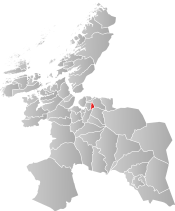Tiller, Norway
Tiller herred | |
|---|---|
 Sør-Trøndelag within Norway | |
 Tiller within Sør-Trøndelag | |
| Coordinates: 63°20′34″N 10°25′34″E / 63.34278°N 10.42611°ECoordinates: 63°20′34″N 10°25′34″E / 63.34278°N 10.42611°E | |
| Country | Norway |
| County | Sør-Trøndelag |
| District | Trondheim Region |
| Established | 1 Jan 1899 |
| Disestablished | 1 Jan 1964 |
| Administrative centre | Heimdal |
| Area | |
| • Total | 24 km2 (9 sq mi) |
| *Area at municipal dissolution. | |
| Population (1964) | |
| • Total | 3,595 |
| • Density | 150/km2 (390/sq mi) |
| Demonym(s) | tillerbygg[1] |
| Time zone | UTC+01:00 (CET) |
| • Summer (DST) | UTC+02:00 (CEST) |
| ISO 3166 code | NO-1661 |
| Preceded by | Klæbu in 1899 |
| Succeeded by | Trondheim in 1964 |
Tiller is a former municipality in the old Sør-Trøndelag county, Norway. The 24-square-kilometre (9.3 sq mi) municipality of Tiller existed from 1899 until its dissolution in 1964. The municipality encompassed part of the south-central part of what is now the municipality of Trondheim in Trøndelag county. The municipality was generally located between the river Nidelva in the east and the Dovrebanen railway line. The administrative centre was located at Heimdal, on the western edge of the municipality. The local Tiller Church was built shortly after the creation of the municipality (1901) to serve its residents.[2]
History[]
The municipality of Tiller was established on 1 January 1899 when the northwestern part of the municipality of Klæbu was split off to form a separate municipality. Initially, Tiller had a population of 533. During the 1960s, there were many municipal mergers across Norway due to the work of the Schei Committee. On 1 January 1964, the neighboring municipalities of Byneset (population: 2,049), Leinstrand (population: 4,193), Strinda (population: 44,600), Tiller (population: 3,595), and the city of Trondheim (population: 56,982) were merged to form the new urban municipality of Trondheim which would have a total population of 111,419.[3]
Government[]
All municipalities in Norway, including Tiller, are responsible for primary education (through 10th grade), outpatient health services, senior citizen services, unemployment and other social services, zoning, economic development, and municipal roads. The municipality is governed by a municipal council of elected representatives, which in turn elects a mayor.[4]
Municipal council[]
The municipal council (Herredsstyre) of Tiller was made up of 19 representatives that were elected to four year terms. The party breakdown of the final municipal council was as follows:
| Party Name (in Norwegian) | Number of representatives | |
|---|---|---|
| Labour Party (Arbeiderpartiet) | 12 | |
| Conservative Party (Høyre) | 2 | |
| Communist Party (Kommunistiske Parti) | 1 | |
| Christian Democratic Party (Kristelig Folkeparti) | 2 | |
| Centre Party (Senterpartiet) | 1 | |
| Liberal Party (Venstre) | 1 | |
| Total number of members: | 19 | |
See also[]
References[]
- ^ "Navn på steder og personer: Innbyggjarnamn" (in Norwegian). Språkrådet.
- ^ Thorsnæs, Geir, ed. (2015-12-22). "Tiller – tidligere kommune". Store norske leksikon (in Norwegian). Kunnskapsforlaget. Retrieved 2018-03-17.
- ^ Jukvam, Dag (1999). "Historisk oversikt over endringer i kommune- og fylkesinndelingen" (PDF) (in Norwegian). Statistisk sentralbyrå.
- ^ Hansen, Tore, ed. (2016-05-12). "kommunestyre". Store norske leksikon (in Norwegian). Kunnskapsforlaget. Retrieved 2020-02-02.
- ^ "Kommunevalgene og Ordførervalgene 1959" (PDF) (in Norwegian). Oslo: Statistisk sentralbyrå. 1960. Retrieved 2020-04-20.
- ^ "Kommunevalgene og Ordførervalgene 1955" (PDF) (in Norwegian). Oslo: Statistisk sentralbyrå. 1957. Retrieved 2020-04-20.
- ^ "Kommunevalgene og Ordførervalgene 1951" (PDF) (in Norwegian). Oslo: Statistisk sentralbyrå. 1952. Retrieved 2020-04-20.
- ^ "Kommunevalgene og Ordførervalgene 1947" (PDF) (in Norwegian). Oslo: Statistisk sentralbyrå. 1948. Retrieved 2020-04-20.
- ^ "Kommunevalgene og Ordførervalgene 1945" (PDF) (in Norwegian). Oslo: Statistisk sentralbyrå. 1947. Retrieved 2020-04-20.
- ^ "Kommunevalgene og Ordførervalgene 1937" (PDF) (in Norwegian). Oslo: Statistisk sentralbyrå. 1938. Retrieved 2020-04-20.
- Former municipalities of Norway
- Geography of Trondheim
- 1899 establishments in Norway
- 1964 disestablishments in Norway
- Populated places disestablished in 1964
- Populated places established in 1899



